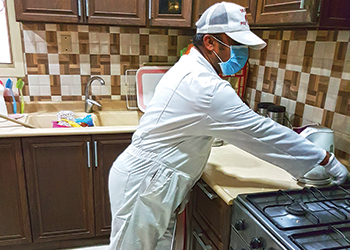
 Sources of infestation should be treated.
Sources of infestation should be treated.
It’s important to identify the source of infestation of houseflies and eliminate it on time, says MIRZA WAQAR AHMAD, an entomologist with Masa Establishment.
Houseflies, the bane of commercial and non-commercial kitchens, feed on human food as well as waste and are a significant transmitter of numerous pathogenic organisms and diseases.
They pick up disease-causing organisms while crawling on surfaces and transmit them when they land on food. It is the agility of a housefly that allows it to visit such diverse and contaminated habitats within a short lifespan, thus makes them major pests.
The housefly may lay eggs in food products present in the kitchens (in both bulk ingredients and finished goods) and these eggs hatch into larvae, which will feed on, and contaminate the food.
Saudi Arabia-based Masa Establishment, under the leadership of Mousaied Al Shieshakly, believes it is vital to consider all facts and figures of housefly management while carrying out an ecologically sound integrated pest management (IPM) programme in various types of facilities. It recommends the following steps and practices:
• Treating the source: The breeding ground of houseflies is often decaying food, such as vegetables, fruits or leftovers. It is very common to discover these flies reproducing inside or under dumpsters near building entrances and then making their way into kitchens. Dirty sinks and the associated drainage system, if not kept clean and treated from inside and outside, serve as the sources of infestations by houseflies and other flies in kitchens. Regular cleaning and sanitation of such sources is the primary step in initiating a durable pest management.
 |
Al Shieshakly ... vision. |
• Preventive measures: Food and utensils should be placed in fly-proof containers, cupboards, and wrapping material. To prevent flies from entering the premises nets and screens can be installed on windows and other openings; auto-closing doors can be made installed; and doorways can be provided with anti-fly curtains, consisting of strings of beads or plastic strips that prevent flies from passing through. Electric fans can create an air barrier across entrances or corridors. Meanwhile, door sweeps or weather stripping can be installed on the doors.
• Sticky glue traps: Sticky glue traps attract houseflies because of their sugary content and trap them. These traps can last for many weeks if not rendered ineffective by dust or trapped houseflies.
• Insect light traps (ILTs): These are gaining popularity to catch flies. ILTs mostly consist of electrocuting grids or glue boards along with the light traps to attract and kill flies on contact.
• Fly bait: Fly baits can be used in protected sites near fly feeding sources. Granular baits are scattered by hand, applied with a granular spreader, or placed in bait stations. However, care should be taken to place them away from garbage, which may make these baits less attractive.
• Chemical control: The usual chemical method to control houseflies indoors is either a non-residual space treatment or residual spray. The space treatment is applied indoors to kill adult flies after the breeding sources have been identified and removed, whereas the residual insecticide can be applied to outdoor areas where flies land to keep them from entering the kitchens. Although the application of effective insecticides can temporarily lead to quick control, flies soon develop resistance to them.
Insecticide treatments are also needed along with IPM techniques.
It is important to locate all possible breeding sources to avoid infestations as it has been observed that infestations continue because one or more breeding grounds have been ignored or have gone unnoticed. However, simply identifying the source of the infestation isn’t enough – these sources need to be treated and the conditions contributing to the problem eliminated on time.
A pest control treatment plan can only remain effective if the kitchen owner or manager carries out detailed sanitation and proper cleaning procedures to clean drains, floor cracks, and areas underneath dishwashers.
Masa Establishment, a member of international pest control organisations such as National Pest Management Association (NPMA), British Pest Control Association (BPCA) and Australian Environmental Pest Managers Association (AEPMA), follows standard procedures to successfully carry out effective pest management of houseflies. The treatment techniques may differ depending on the location of the pests, whether they are inside or outside the kitchens. Its professional pest control consultants always determine the required actions during the inspection prior to recommending and implementing the treatment.





















_0001.jpg)


.jpg)
















.jpg)








.jpg)


